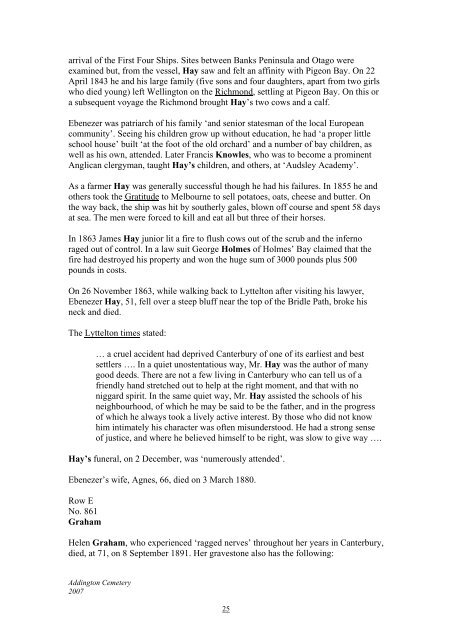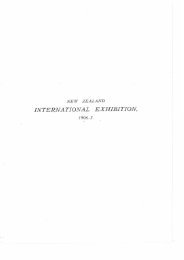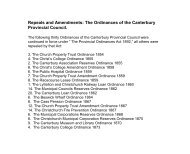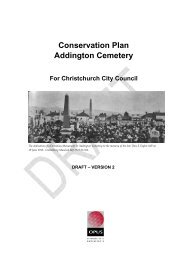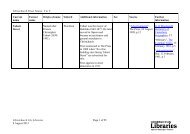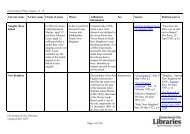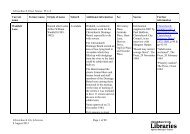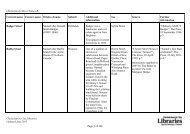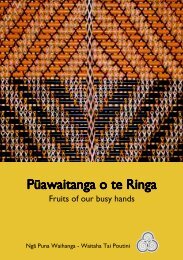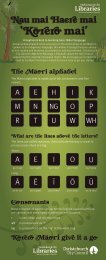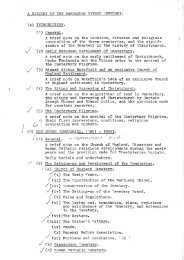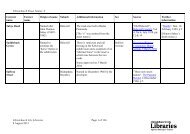Addington Cemetery Tour Guide - Christchurch City Libraries
Addington Cemetery Tour Guide - Christchurch City Libraries
Addington Cemetery Tour Guide - Christchurch City Libraries
You also want an ePaper? Increase the reach of your titles
YUMPU automatically turns print PDFs into web optimized ePapers that Google loves.
arrival of the First Four Ships. Sites between Banks Peninsula and Otago were<br />
examined but, from the vessel, Hay saw and felt an affinity with Pigeon Bay. On 22<br />
April 1843 he and his large family (five sons and four daughters, apart from two girls<br />
who died young) left Wellington on the Richmond, settling at Pigeon Bay. On this or<br />
a subsequent voyage the Richmond brought Hay’s two cows and a calf.<br />
Ebenezer was patriarch of his family ‘and senior statesman of the local European<br />
community’. Seeing his children grow up without education, he had ‘a proper little<br />
school house’ built ‘at the foot of the old orchard’ and a number of bay children, as<br />
well as his own, attended. Later Francis Knowles, who was to become a prominent<br />
Anglican clergyman, taught Hay’s children, and others, at ‘Audsley Academy’.<br />
As a farmer Hay was generally successful though he had his failures. In 1855 he and<br />
others took the Gratitude to Melbourne to sell potatoes, oats, cheese and butter. On<br />
the way back, the ship was hit by southerly gales, blown off course and spent 58 days<br />
at sea. The men were forced to kill and eat all but three of their horses.<br />
In 1863 James Hay junior lit a fire to flush cows out of the scrub and the inferno<br />
raged out of control. In a law suit George Holmes of Holmes’ Bay claimed that the<br />
fire had destroyed his property and won the huge sum of 3000 pounds plus 500<br />
pounds in costs.<br />
On 26 November 1863, while walking back to Lyttelton after visiting his lawyer,<br />
Ebenezer Hay, 51, fell over a steep bluff near the top of the Bridle Path, broke his<br />
neck and died.<br />
The Lyttelton times stated:<br />
… a cruel accident had deprived Canterbury of one of its earliest and best<br />
settlers …. In a quiet unostentatious way, Mr. Hay was the author of many<br />
good deeds. There are not a few living in Canterbury who can tell us of a<br />
friendly hand stretched out to help at the right moment, and that with no<br />
niggard spirit. In the same quiet way, Mr. Hay assisted the schools of his<br />
neighbourhood, of which he may be said to be the father, and in the progress<br />
of which he always took a lively active interest. By those who did not know<br />
him intimately his character was often misunderstood. He had a strong sense<br />
of justice, and where he believed himself to be right, was slow to give way ….<br />
Hay’s funeral, on 2 December, was ‘numerously attended’.<br />
Ebenezer’s wife, Agnes, 66, died on 3 March 1880.<br />
Row E<br />
No. 861<br />
Graham<br />
Helen Graham, who experienced ‘ragged nerves’ throughout her years in Canterbury,<br />
died, at 71, on 8 September 1891. Her gravestone also has the following:<br />
<strong>Addington</strong> <strong>Cemetery</strong><br />
2007<br />
25


